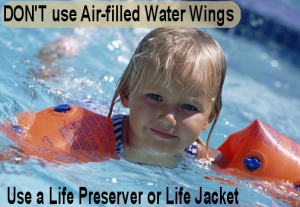Recreational water illnesses (RWIs) are caused by germs spread by swallowing, breathing in mists or aerosols of, or having contact with contaminated water in swimming pools, hot tubs/spas, interactive fountains, lakes, rivers, or oceans.
RWIs can also be caused by chemicals in the water or chemicals that evaporate from the water and trigger indoor air quality problems. In addition to illnesses, injuries — such as drowning and slips, trips, and falls — can occur in or around the water.
A new CDC study found that swimmers frequently bring poop into the water. This can happen when swimmers do not  shower with soap before they start swimming or when they have a diarrheal incident in the pool. Poop might contain germs, which can be swallowed by others in the water and make them sick.
shower with soap before they start swimming or when they have a diarrheal incident in the pool. Poop might contain germs, which can be swallowed by others in the water and make them sick.
Remember, you share the water you swim in with everyone who enters the pool, and contrary to popular belief, chlorine and other disinfectants do not kill germs instantly. Once germs get into the pool, it can take anywhere from minutes to days for chlorine to kill them. Before they are killed, these germs can cause RWIs, such as gastrointestinal, skin, ear, respiratory, eye, neurologic, and wound infections. The most commonly reported RWI is diarrhea caused by germs such as Crypto (short for Cryptosporidium), Giardia, Shigella, norovirus and E. coli O157:H7. Swallowing just a little water that contains these germs can make you sick.
With the number of RWI outbreaks on the rise, swimmers need to take an active role in helping to protect themselves and prevent the spread of germs. The simple steps below can help you protect yourself and other swimmers from germs in the water you swim in.
Tips for Swimmers
We all share the water we swim in, and we each need to do our part to keep ourselves, our families, and our friends healthy. To help protect yourself and other swimmers from germs, here are a few simple and effective steps all swimmers can take each time we swim:
Keep the poop, germs, and pee out of the water.
Don’t swim when you have diarrhea.
Shower with soap before you start swimming.
Take a rinse shower before you get back into the water.
Take bathroom breaks every 60 minutes.
Wash your hands after using the toilet or changing diapers.
Drowning
Drowning is the leading cause of injury death among children 1–4 years old. Every day, 10 people die from drowning; 2 of those 10 are children under the age of 15 years. Of drowning victims who survive and are treated in emergency departments, more than half are hospitalized or transferred for further care. These individuals often experience brain damage, which can cause memory problems, learning disabilities, or permanent loss of basic functioning (or permanent vegetative state).
 To prevent drowning:
To prevent drowning:
Everyone (adults and children) should know how to swim.
Caregivers should know CPR.
All boaters and weaker swimmers should use lifejackets.
Backyard swimming pools should be separated from the house and yard by a fence with a self-closing and self-latching gate.
Free pool test strips: Go to the Water Quality & Health Council (WQHC)’s Healthy Pools page to order and receive free test strips: http://www.healthypools.org/order-pool-kit-form/
Sunscreen Protection:
Here: https://reyessyndrome.wordpress.com/category/kids-and/kids-and-sunscreen/ is some good sunscreen information – all products are chemical and salicylate free.
And remember: Never give a child aspirin, or aspirin products under the age of 19 for relief of sunburn – you could trigger Reye’s Syndrome – a deadly disease. Children under the age of 19 should never be given aspirin without a doctor’s orders.
Other Resource Links:
Effectiveness of Sunscreen Products
Like this information?

